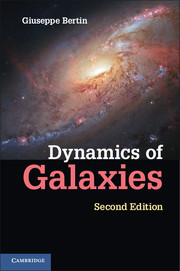Book contents
- Frontmatter
- Contents
- Preface to the Second Edition
- Preface to the First Edition, 2000
- Acknowledgments
- PART I Basic Phenomenology
- PART II Physical Models
- PART III Spiral Galaxies
- 13 Orbits
- 14 The Basic State: Vertical and Horizontal Equilibrium of the Disk
- 15 Density Waves
- 16 Roles of Gas
- 17 Global Spiral Modes
- 18 Spiral Structure in Galaxies
- 19 Bending Waves
- 20 Dark Matter in Spiral Galaxies
- PART IV Elliptical Galaxies
- PART V In Perspective
- Bibliography
- Index of objects
- Index
18 - Spiral Structure in Galaxies
from PART III - Spiral Galaxies
Published online by Cambridge University Press: 05 June 2014
- Frontmatter
- Contents
- Preface to the Second Edition
- Preface to the First Edition, 2000
- Acknowledgments
- PART I Basic Phenomenology
- PART II Physical Models
- PART III Spiral Galaxies
- 13 Orbits
- 14 The Basic State: Vertical and Horizontal Equilibrium of the Disk
- 15 Density Waves
- 16 Roles of Gas
- 17 Global Spiral Modes
- 18 Spiral Structure in Galaxies
- 19 Bending Waves
- 20 Dark Matter in Spiral Galaxies
- PART IV Elliptical Galaxies
- PART V In Perspective
- Bibliography
- Index of objects
- Index
Summary
With most of the necessary dynamical tools already introduced, we now turn to the astrophysical problem. In this chapter we will try to highlight only some important points. The reader is referred to the monograph by Bertin and Lin (1996) for the full definition of the astrophysical issues involved, a physical outline of the modal theory in the semiempirical context, and the description of many important observational tests not mentioned here.
Spiral structure in galaxies has been the focus of a vast set of observational and theoretical investigations during the entire twentieth century. A decisive turning point in the course of these studies was the realization, in the early 1960s, that density waves are at the basis of the most spectacular phenomena associated with spiral structure. In particular, this realization came as the conclusion of the pioneering work of Bertil Lindblad, who first formulated the hypothesis that the large-scale spiral structure in galaxies is quasi-stationary despite the presence of differential rotation in the disk. Because of differential rotation, any material structure could not persist but would be stretched and would wrap up on a very short time scale. This is commonly known as the winding dilemma. In contrast, as the manifestation of waves, the density concentrations that define the spiral arms could move in the disk in a manner that is, to a large extent, decoupled from the motion of the individual particles (stars or gas clouds) that support it, much like a sound wave in an ordinary gas. Thus spiral arms, if associated with a wave phenomenon, could survive differential rotation as quasi-stationary patterns.
- Type
- Chapter
- Information
- Dynamics of Galaxies , pp. 247 - 265Publisher: Cambridge University PressPrint publication year: 2014
- 2
- Cited by



